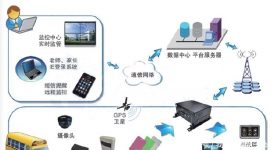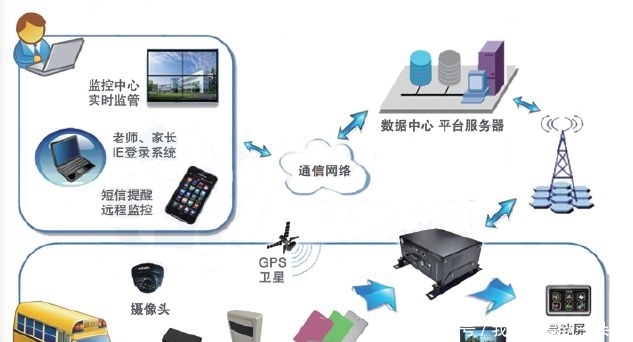
Internet of Things RFID school bus safety management technology allows school buses to travel safely
[ad_1]
In our country, school buses mainly refer to the means of transportation specially used by underage students in kindergarten, elementary school, and middle school. Due to the general lack of safety awareness among young children and elementary school students, the most important aspect of school bus safety is traffic safety. Traffic safety is hidden from overloading, speeding, driver’s illegal driving, fatigue driving, etc., as well as potential infringements on school buses from other vehicles driving on the highway. Secondly, school bus safety also includes the personal safety of the students inside the vehicle when the school bus is running, and the vehicle mechanical and electrical safety.
Internet of Things RFID school bus safety management technologyLet the school bus go safely.
The Internet of Things technology integrates technologies such as sensing, remote communication, networking, and computer information systems. The use of radio frequency identification, global satellite positioning, geographic information system, and network technology at the core of the Internet of Things technology can achieve comprehensive real-time monitoring of school bus mechanical and electrical safety, driving safety, driver safety, and student safety, etc., for school bus safety Management provides the most timely and accurate basic data. And the Internet of Things technology has matured in traffic safety. Among them, RFID is the main carrier of IoT applications. RFID technology is mainly used for identification in the school bus safety management system. In the school bus safety management, the geographic information system can describe the vehicle trajectory in the form of graphics, display the road traffic status, locate the accident point, dispatch emergency rescue, and provide traffic command plans.
The school bus safety management system is divided into three subsystems, corresponding to three integrated working platforms, namely, school bus on-board subsystem (vehicle platform), school bus school management subsystem (daily management platform), and departmental school bus supervision subsystem (supervision platform).
The main data inside and between the platforms of the school bus safety management system are: (1) GPS data of the vehicle, based on which the vehicle speed and running track can be calculated; (2) Personnel RFID information, real-time information available on this basis The number of passengers and the basic information of each student on the bus; (3) The mechanical and electrical data during the operation of the vehicle can be compared with normal vehicle parameters to determine the safety status of the school bus and provide early warning of abnormal conditions; ( 4) Video information in the car, including the real-time situation in the car, the working conditions of the driver and the teacher in the car, the situation of students getting on and off the car and parent pick-up, etc.; (5) Geographical information, traffic conditions, text information (such as weather information, special notices) Etc.), regulatory instructions, etc.

The on-board subsystem of the school bus mainly includes RFID readers, GPS receiving equipment, video monitoring facilities, alarm devices and wireless communication devices. High-performance school buses can be equipped with vehicle mechanical and electrical performance sensing equipment. The on-board subsystem is the most basic part of the school bus safety management system. It not only transmits important real-time raw data, but also accepts control information from the management platform. In order to ensure the smooth operation and convenient operation of the on-board subsystem, the on-board subsystem should be integrated into an overall operating platform. The vehicle platform mainly integrates the following facilities:
(1) RFID equipment: The on-board RFID reader automatically obtains the accurate number of people getting on and off the bus through the electronic wristband worn by the student; reads the identity of the driver and the escort teacher RIFD. When the parent picks up the child, reads the parent holding Remote identification of RFID cards allows drivers and teachers to obtain parent information through voice, avoiding counterfeiting and wrong connection. The actual number of people in the bus is displayed in the appropriate position with eye-catching numbers to avoid accidents where children are left on the bus when the school bus stops.
(2) Video surveillance equipment: The video is collected and stored through the cameras installed at various key positions in the car, and the video data is sent to the school management center through the 3G high-speed wireless communication network.
(3) GPS equipment: Obtain real-time dynamic spatial coordinate information of school bus operation, and transmit it to the system for processing and calculation.
(4) Wireless communication device: Choose 3G high-speed wireless communication network to ensure smooth signal and complete video data transmission with huge traffic.
(5) Alarm system: automatic alarm and automatic braking and deceleration when the vehicle is mechanically or electrical failure; alarm and automatic activation of fire extinguishing device in case of fire; automatic call in with 110, 120 and other public alarm systems in dangerous situations; manual alarm button, In special circumstances, the driver sends an alarm signal to the school management center.
The school management platform mainly completes the daily management of the school bus and uploads the school bus operation data to the supervision platform in real time. The school bus school management subsystem network adopts the model of 3G mobile communication network + high-speed broadband network (twisted pair or optical fiber high-speed star Ethernet). Use the wireless communication network and the mobile school bus vehicle-mounted platform to realize data transmission, and realize the connection with the supervision system of relevant government departments through the high-speed broadband network. The school management subsystem adopts multiple computers to form a local area network, and completes the reception of video surveillance information, GPS tracking and positioning, and real-time reception of personnel and vehicle information in parallel. The main functions of the school management platform are:
(1) Vehicle GPS positioning and tracking
Receive geographic coordinate information sent by the vehicle GPS to locate and track school buses. Schools with conditions can be equipped with GIS geographic information system to automatically display the location information on the electronic map. The administrator can obtain the exact location, speed, driving path, etc. of the school bus. Ensure that the school bus runs during normal hours and on designated routes to prevent speeding, unauthorized changes to the route, etc.
(2) Text message sending and receiving
It can send warning messages to remind the driver of the abnormal driving of the school bus, and can also send and receive temporary short messages, notifications and other text information, such as weather, road conditions, abnormal conditions, etc.
(3) RFID information management
Including the issuance, data entry and update of various RFID cards. This function is the most important function in the school bus safety management system, and it can well reflect the benefits of the application of the Internet of Things technology in the school bus safety management.
The RFID cards required by the system mainly include driver card, faculty card, student boarding card, and parent pick-up card. Among them, the driver card and the faculty card use RFID cards that can be read at close range. Faculty and staff cards can be subdivided into school principals, school bus safety inspection attendants, and vehicle escort personnel cards. The RFID cards of faculty, staff and drivers can also be used for electronic attendance, access control, system authorization, etc. Student travel cards use electronic wristbands, especially kindergarten children must use electronic wristbands, which are easy to wear and use. The student RFID card contains his name, gender, age, class, home address, contact information, photo, etc. The parent card uses a remotely read RFID card, so that parents can identify their identity without getting in the car. In order to ensure that the child is safely and correctly delivered to the parent, it is best to adopt the “dual card matching” security mechanism, that is, when the parent card and the student card information worn by the child are consistent, the parent is allowed to pick up the child. Due to the RFID card, the detailed information of students getting on and off the bus and parents picking up and dropping off can be automatically recorded by the system.
An important function of this module is to dynamically obtain the actual number of people in the vehicle to prevent overloading. At the same time, it prevents students from missing stops, stops by mistake, or is forgotten in the car through comparison with the school-registered student ride data.
(4) Home-school contact: mainly for schools/parents to publish/inquire about school bus operation and student rides through the Internet, text messages, telephone, etc.
(5) System maintenance: functions such as entering basic information, user authority management, data statistics, and analysis.
The safety supervision subsystem is used by supervisory departments, such as education authorities, safety supervision, traffic police, etc. Through the supervision platform, the supervision department can obtain real-time information on the number of passengers, videos, vehicle ownership of the school, and speed of all school buses in the jurisdiction, and issue supervision opinions to the school management center; use the administrative area GIS electronic map, traffic management and command information With the system, the supervisory department can also check the running routes of the school buses in the area, and conduct reasonable traffic command based on the traffic conditions, so as to provide convenient traffic conditions for the school buses.
The safety of school buses affects thousands of households and affects family happiness and social stability. The Internet of Things technology has mature application experience in transportation, public transportation and other fields similar to school bus operations. Therefore, the development and application of a school bus safety management system based on the Internet of Things technology has practical significance and feasibility. The use of advanced Internet of Things technology can give full play to the rigid and “selfless” characteristics of technical means, and build an important technological protective wall for school bus safety.
[ad_2]




